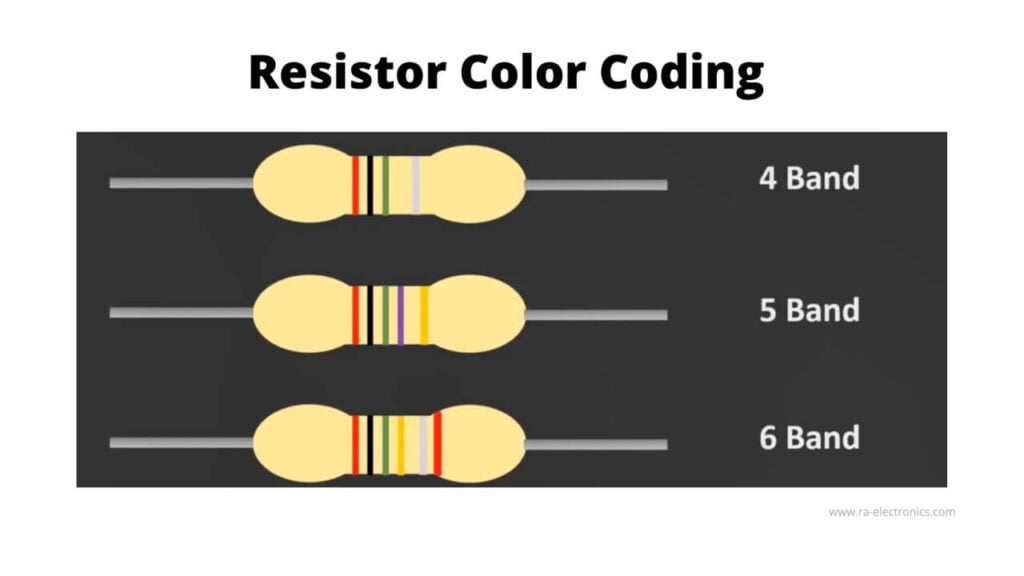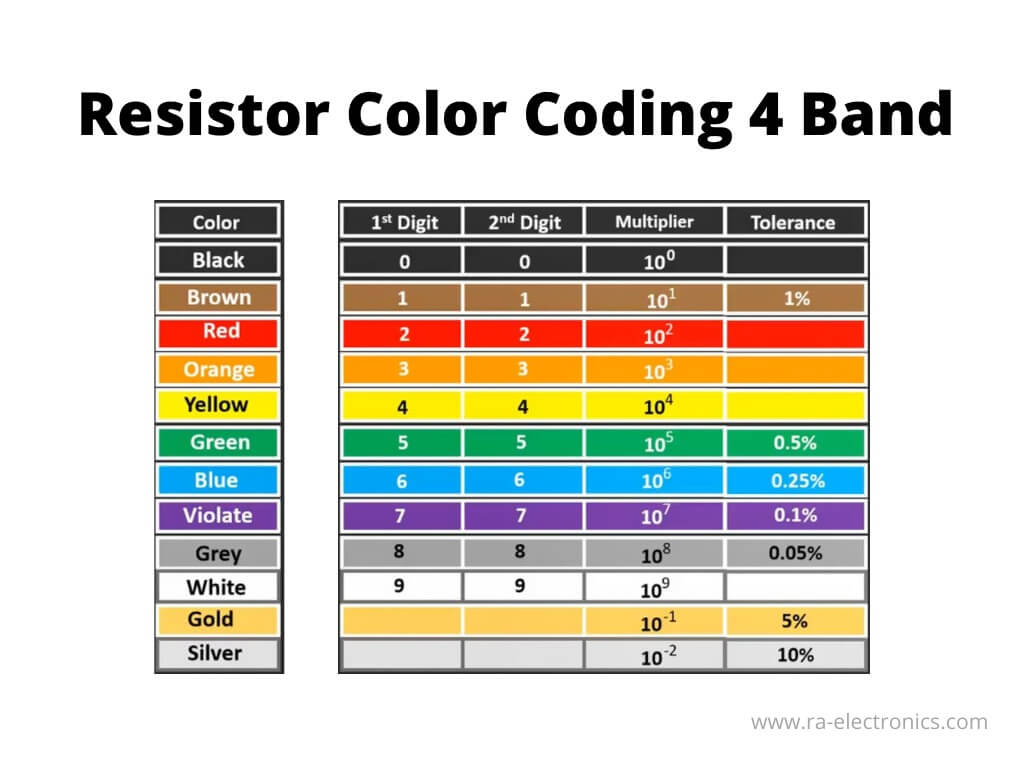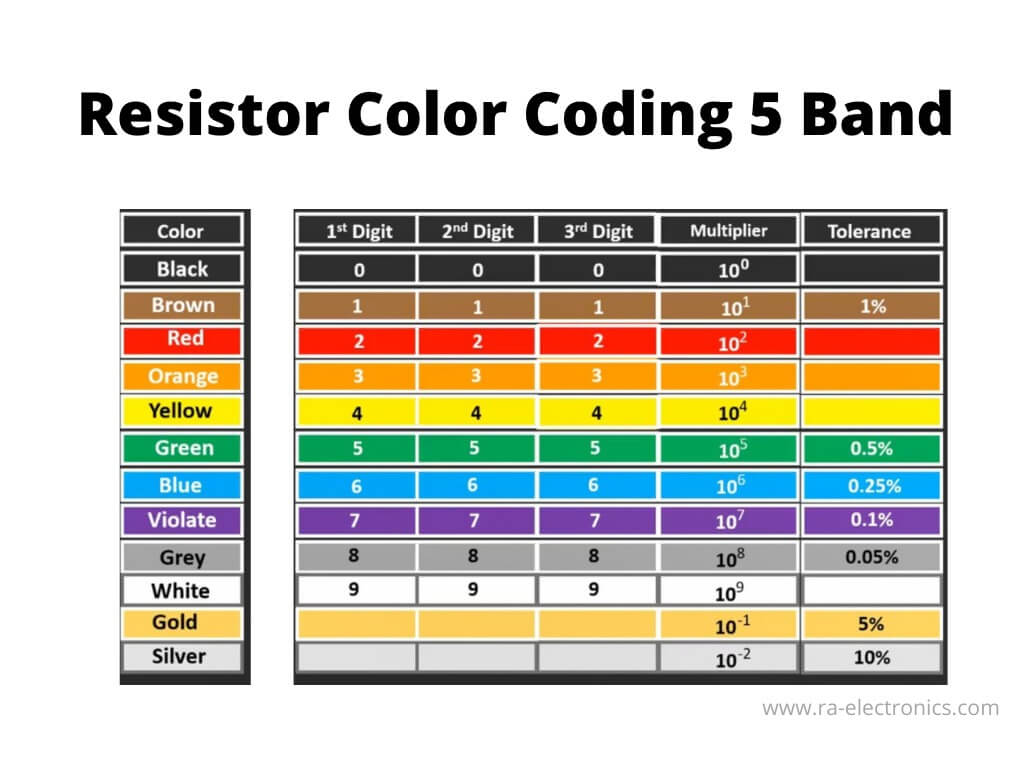A resistor color code is a system used to identify the resistance value of resistors using colored bands printed on their surface. Each color represents a number, and by reading these bands in a specific order, you can determine the resistor’s value, tolerance, and sometimes even reliability. For beginners, the most common resistors use four or five color bands, and learning to decode them is essential for any electronics project.
This guide breaks down each color’s meaning, offers a simple step-by-step method to read the bands, and provides practical examples to help you confidently identify resistor values.
If you’re new to resistors and want to understand their basics, check out our Introduction to Resistors: A Beginner’s Guide.
What is Resistor Color Coding?
Resistor color coding is a universal system where each resistor has a set of colored bands that indicate its resistance value, multiplier, and tolerance. This system was developed by the Radio Manufacturers Association (RMA) in the 1920s and later standardized by the Electronic Industries Association (EIA).
Each color represents a specific digit, making it easy to decode the resistance value using a color chart.
Types of Resistor Color Coding
Now, the commercially available resistors can have either four, five, or six bands, depending upon the number of color bands. These resistors are known as either four-band, five-band, or six-band resistors.

1. 4 Band Resistor
Let us find out how to find the value of these four-band resistors.

If you look at a four-band resistor, you’ll notice four color bands on it. Here’s what each band represents:
- First two bands → These give you the first two digits of the resistance value.
- Third band → This acts as a multiplier, telling you how many zeros to add.
- Fourth band → This shows the tolerance, meaning how much the actual resistance can vary.
The resistance value changes based on the colors of these bands.
Now, let’s break down what each color represents and how it helps determine the resistor’s value. Check out the table below!

How to Read 4-Band Resistors
As you can see in the table below, the first two columns represent the first two color bands of the resistor. The value of these bands determines the first two digits of the resistance.
Similarly, the next two columns show the multiplier and tolerance. These values also change based on the colors of the bands.
By using this table, you can easily decode the resistance value of any resistor!
Example: Reading a 4-Band Resistor
Let’s say you have a 4-band resistor with the following colors:
🟢 Green | 🔴 Red | 🟡 Yellow | 🏅 Gold
Step-by-Step Calculation:
1️⃣ Green (5) → First digit
2️⃣ Red (2) → Second digit
3️⃣ Yellow (×10,000) → Multiplier
4️⃣ Gold (±5%) → Tolerance
Final Resistance = 52 × 10,000 = 520,000Ω (or 520kΩ) ±5%
This means the actual resistance can vary between 494kΩ and 546kΩ.
This is how you quickly read a 4-band resistor using color coding!
2. 5 Band Resistor
Now, let us find out how to find the value of the resistor when it has a five-color band.

How to Read 5-Band Resistors
For a 5-band resistor, the color bands are interpreted as follows:
- First three bands → Represent the first three digits of the resistance value.
- Fourth band → Acts as a multiplier, determining how many zeros to add.
- Fifth band → Indicates the tolerance, showing how much the actual resistance can vary.
The table below provides a clear breakdown of each color’s value, including the digits, multiplier, and tolerance based on the resistor’s color bands. This makes it easy to calculate the exact resistance!

Example: Reading a 5-Band Resistor
Let’s say you have a 5-band resistor with the following colors:
🔵 Blue | 🟠 Orange | 🟡 Yellow | ⚫ Black | 🥈 Silver
Step-by-Step Calculation:
1️⃣ Blue (6) → First digit
2️⃣ Orange (3) → Second digit
3️⃣ Yellow (4) → Third digit
4️⃣ Black (×1) → Multiplier
5️⃣ Silver (±10%) → Tolerance
Final Resistance = 634 × 1 = 634Ω ±10%
This means the actual resistance can vary between 570Ω and 697Ω.
This is how you accurately determine the resistance of a 5-band resistor using color coding!
3. 6 Band Resistor
6-band resistors are not commonly used in general-purpose circuits but are essential for specialized applications like precision electronics and military-grade equipment.
Here’s how the color bands work in a 6-band resistor:
- First three bands → Represent the first three digits of the resistance value.
- Fourth band → Acts as the multiplier, determining how many zeros to add.
- Fifth band → Indicates the tolerance, showing the possible variation in resistance.
- Sixth band → Represents the Temperature Coefficient of Resistance (TCR), which tells how much the resistance changes with temperature.
Since these resistors offer high precision and stability, they are widely used in aerospace, military, and high-end electronic devices.

Here is a table from which we can find the value of the individual digits as well as the value of the multiplying factor.

Example: Reading a 6-Band Resistor
Let’s say you have a 6-band resistor with the following colors:
🟢 Green | 🔵 Blue | 🟠 Orange | 🔴 Red | 🤎 Brown | 🔵 Blue
Step-by-Step Calculation:
1️⃣ Green (5) → First digit
2️⃣ Blue (6) → Second digit
3️⃣ Orange (3) → Third digit
4️⃣ Red (×100) → Multiplier
5️⃣ Brown (±1%) → Tolerance
6️⃣ Blue (10 ppm/°C) → Temperature Coefficient
Final Resistance = 563 × 100 = 56,300Ω (or 56.3kΩ) ±1%
This means the actual resistance can vary between 55.7kΩ and 56.9kΩ.
The TCR of 10 ppm/°C means the resistance changes by 10 parts per million per degree Celsius.
This level of precision and stability makes 6-band resistors ideal for high-reliability applications like aerospace and military electronics!
Conclusion: Why You Should Master Resistor Color Coding
Whether you’re a beginner or an experienced engineer, knowing how to read resistor values is an essential skill in electronics. By following this guide and practicing with different resistors, you’ll become proficient in identifying and using resistors in your projects.
For quick calculations or verifying resistor values, try our online resistor calculator. With this knowledge and the right tools, you’ll be able to work with resistors confidently in any electronic circuit.
If you’re working on circuits and need a platform to build them, learn more in our Beginner’s Guide: Introduction to Breadboards.